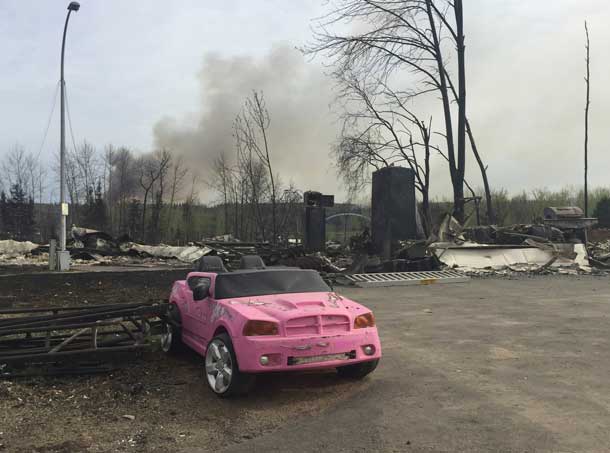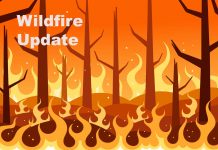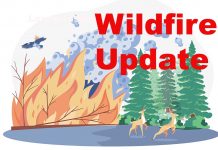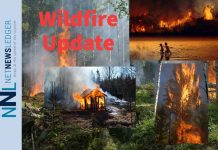THUNDER BAY – The forest fire situation in Northwestern Ontario is reduced to low to moderate.
Northwest Region
There was one new fire in the Northwest region by the late afternoon of June 9, 2019
- Nipigon 5 was located approximately 5.5 kilometres north of Geraldton. The fire is out at 0.1 hectares.
There were five active fires in the Northwest Region at the time of this report. Two of the fires were not under control, two were being held and one fire was under control.
Sioux Lookout 8 near Pickle Lake
Sioux Lookout 8 near Pickle Lake (833 hectares) is responding well to rain following a day of active fire behavior on Saturday. A total of 17 crews are assigned to the fire, command over which has transitioned to an Incident Management Team. Heavy equipment has constructed over 2.5 kilometres of fire guard in critical areas and values protection (sprinkler) systems have been installed on buildings and infrastructure as a precaution.
Red Lake 14 near Pikangikum
Red Lake 14 near Pikangikum has received significant rainfall over the past 48 hours. The fire is now being held at 3835 hectares. There are 24 crews assigned to this fire with additional support staff. Crews continue to identify and extinguish hot spots and have begun to remove values protection (sprinkler) equipment from buildings and infrastructure.
Community Update from Chief Sainnawap: COMMUNITY ALERT FROM IFNA EOC
“The status of the fire is still Being Held. There is no longer an imminent threat but we stress THE IMPORTANCE OF REMAINING CAUTIOUS. We are still waiting for the status of the fire to be Under Control.
“However, SELF-EVACUEES (individuals who left the community by their own means and not by plane) can start returning to the community tomorrow, June 10th. Community members who left by plane will return by plane; a return schedule for this large category of evacuees is currently being prepared by the MNRF with information on flights returning to the community. Once verified, that schedule will be posted as soon as possible, so please monitor this page where the information will be posted. Thank you for your continued patience and cooperation.”
Red Lake 17
Seven crews are working on this fire located northwest of Trout Lake in the Red Lake sector. The fire is currently sized at 6803 hectares and is not under control. Rain is the area is helping the suppression effort and values protection equipment has been set up in various locations as a precaution. An Incident Management Team assumed command of the fire, Sunday.
Fire hazard for the Northwest Region
The forest fire hazard is currently low to moderate in the Red Lake, Kenora, Dryden and Sioux Lookout sectors. The Thunder Bay and Nipigon sectors feature a high to extreme fire hazard.
AFFES staff deployed out of province
Approximately 230 staff members from Aviation, Forest Fire and Emergency Services are assisting the province of Alberta with its escalated fire situation. This includes FireRangers, support staff and one incident management team. In addition, the Ministry of Natural Resources and Forestry is providing equipment such as pumps, hose and hand tools to support Alberta.
More than 50 staff members from Aviation, Forest Fire and Emergency Services have been deployed to assist the Yukon with current active forest fires. This includes FireRangers and support staff.
There are also an additional 2 support staff members from Ontario who have been deployed out of province, one to assist the Canadian Interagency Forest Fire Centre in Winnipeg, and one to the Northwest Territories.
The sharing of resources across Canada is facilitated by the Canadian Interagency Forest Fire Centre in Winnipeg under the Mutual Aid Resource Sharing agreement.
The fire situation in Ontario has been relatively quiet since the beginning of the 2019 fire season, and we remain fully prepared to respond to any forest fires that may arise here at home.
Help prevent forest fires
Adopt safe campfire practices! Choose the site of your campfire carefully and keep your fire small. Stay nearby: never leave it unattended. Put your fire out by drowning it with water. Be sure that it is extinguished prior to leaving the site. Stir the ashes with a stick to uncover hot coals and then drown it again. You can never be too safe.
Consider alternatives to burning brush or yard waste, such as chipping or composting when possible, or saving burn piles for the fall or after the fire season. Use of outdoor fires must follow the outdoor burning rules set out in the Forest Fire Prevention Act of Ontario. Fires are to be started no sooner than two hours before sunset and extinguished no later than two hours after sunrise. Fires should never be left unattended and tools and water should be close at hand to put the fire out. More details on outdoor burning regulations can be found online at Ontario.ca/forestfire
To see a complete list of fires across the province click on our interactive map. You can also get the latest update on the condition of any fire by clicking the fire icon.
Fire numbers and online information:
- Forest Fire Reporting Number – 310-FIRE (3473)
- Twitter account
Report prepared by Chris Marchand





